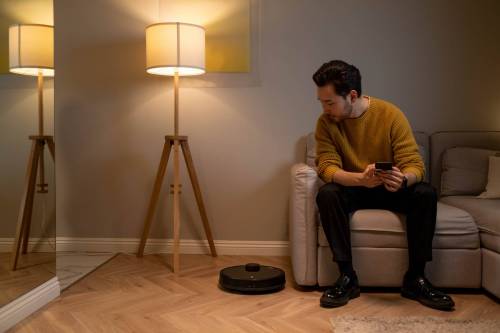

Having internet-connected TVs, cameras, watches, speakers, phones, tablets, and other devices makes our lives more convenient. But, unfortunately, many of these standard “Internet of Things” (IoT) devices require us to share our personal or financial information with them — often without question.
But, there’s no guarantee that the devices themselves and the information you provide will be kept safe. While not intentional. This could open you up to cyber-attacks. Or, it could unintentionally expose your personal information over the internet — mainly if vendors store your personal and financial data in databases.
Don’t you think that could happen to you? Well, it’s been reported that hackers attack every 39 seconds. However, considering the increase in remote and hybrid work, this could have increased. And, it’s also been found that, on average, 300,000 websites are hacked daily.
So, it should go without saying that keeping your smart home tech safe should be paramount. And, if you own a website, this is also true. But did you know that smart home tech can actually teach you about site safety?
1. Change default names and passwords.
The excitement of setting up your new smart home product may cause you to overlook changing its default credentials like usernames, passwords, and woke words. Suffice to say, that can be a costly mistake. It’s easy for hackers to capitalize on your excitement, or laziness since they can easily crack these defaults.
Again, and this can’t be stressed enough, hackers are skilled at finding common passwords and identifying personal information to crack your network. Change your smart device’s defaults to make this more challenging for them. Also, don’t use identifying words or numbers like birthdays. Instead, use a unique combination of letters, numbers, and symbols.
If you have trouble remembering your passwords, you can try using a password manager like LastPass. Tools like this will securely remember all of your passwords for you so that you don’t have to.
Just like with your smart devices, make your site password uncrackable. And that means not using the most common password, 123456. Yes. People still use that as their password after all these years.
2. Sharing isn’t always caring.
Let’s be blunt. There is no way to manage smart devices other than those you know about. However, taking an inventory of your smart home devices can assist you in identifying when someone is trying to access your network. As well as enabling you to identify who has access quickly, you can also set up names for each of your devices and grant access to those who know.
Maintain a list of all the devices and users connected to your network. And make sure that they all have the latest software installed.
As for website owners, the same concept applies. For example, if you’re a business owner, only allow the right team members access to the site. That would probably mean only content creators or your IT department. If your accountant isn’t writing blog posts for you, they probably don’t need the site’s login information.
3. Keep up with the latest and greatest.
Make sure all of your IoT devices are updated with the latest firmware and patches if you want them to be smart, as well as safe. After all, most updates result from a security flaw being found in the old version that hackers have exploited.
In short, using outdated software is like leaving your back door unlocked. So, always keep your website up-to-date. This is especially true if you’re using a CMS containing various valuable plugins and extensions since this is the leading cause of website infections.
Overall, maintain an up-to-date content management system, plugins, apps, and any scripts you use on your website to keep it safe from hacking.
You can quickly check your status if you have a WordPress website by logging into your WordPress dashboard. Your site name will be located in the top left corner next to the update icon. From there simply, click the number to see what WordPress updates are available.
4. Enable multi-factor authentication.
You must confirm your identity using two different methods when you log in with two-factor authentication. For example, after you input your password, a text message with a code will be sent to your cell phone. After receiving the code, you’ll enter on the program or device you’re trying to access between seconds and minutes later.
However, not all smart home devices support this extra layer of security. So, you should stick to devices that come equipped with this feature.
5. Beware of prying eyes and ears.
Whenever a device responds to a voice command, it’s constantly listening. That’s why it’s common for Amazon Echo (“Alexa”) and Google Home Assistant (“Hey, Google”) to record sensitive conversations.
The fact that your devices are tethered to a speaker with a microphone means hackers can easily access things you say, such as your vacation plans and passwords. However, simply muting these devices can be the quick fix to this quandary.
If you’re using smart tech while using your site, this is, well, sound advice. But, in addition to muting these devices, be aware that hackers can spy on your screen. This isn’t exactly a new tactic. But, for those who aren’t in the know, attackers do this by redirecting you to a site that mirrors sites you trust, like your website log in or banking website.
Another way that these nefarious individuals can steal sensitive data is by randomly recording on your webcam to catch your passwords when you type them. To prevent this, use some techniques already discussed, such as two-factor authentication and keeping your site updated.
Also, avoid interacting with pirated material. Be careful when clicking on suspicious links or clicking on suspicious emails. And, don’t use USBs that don’t belong to you.
6. Secure your network.
Connecting to an unsecured network is never a good idea! Hackers can access any data you transmit through your smart home device using public WiFi.
Most ISPs provide a web portal or application that users can use to view devices connected to the network and change settings such as network IDs and encryption levels.
There’s not much deviation here for website owners. Always keep your site safe by only connecting to secure networks. Also, if you have customers providing payment information, only use HTTPS. And install SSL. SSL certificates protect the communication between your website and the server by encrypting information.
7. Have a backup plan.
Instead of your computer and mobile devices’ primary Wi-Fi networks, join a separate guest network for your smart home. Why? Because smart devices cannot be infected as long as they are not connected to your primary network.
As for site owners, these could be regularly running backs to protect you against the worst-case scenario.
While a data breach will be stressful no matter what, having a recent backup means you’ll be more likely to recover from it quickly. You could make daily or weekly backups of your website a habit. Or, invest in automatic backups if you think there is a possibility that you’ll forget to do this. That way, you’ll always be protected.
8. Monitor users.
In today’s world, where kids spend more and more time on devices, it’s essential to set the age settings appropriately. Unfortunately, in most cases, hackers will gain access to children’s websites and videos via what seem to be harmless links.
I’m in no way insinuating that you treat your team like children. But, you should teach them the basics if they can log in to your site.
For instance, set standards for all website users in terms of characters and length when it comes to passwords. If your team members want to use 123456 on their personal accounts, that’s provocative. But, that won’t fly when it comes to your business.
You could also educate them on the most common cyber threats like phishing scams and the dangers of public WiFi.
Image Credit: Cottonbro; Pexels; Thank you!











Albert Costill
My name is Albert Costill and I'm a content marketer at Calendar. If I can help people become more productive in my journey, even better. If you ever have a question about your Calendar or how you can use it - - don't hesitate to reach out. I'm a Calendar Pro.